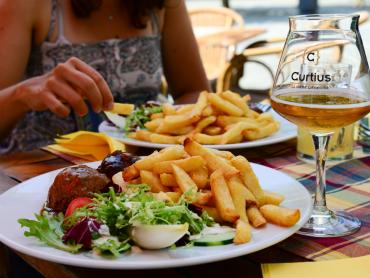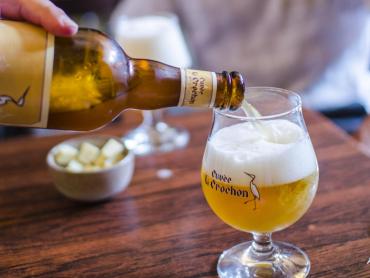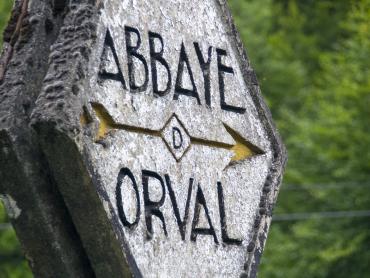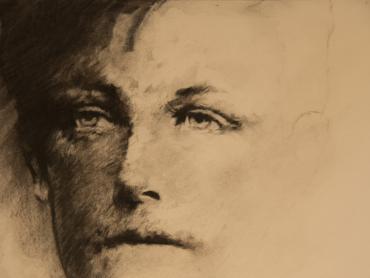Furfooz - Blaimont - Hastière-Lavaux (The nature reserve )
À Furfooz
A - Furfooz - Hauterecenne Voir sur la carte

Below the village of Furfooz, a rocky promontory, like a fortress, was used as a place of refuge by local people from prehistoric times to the Early Middle Ages. Hauterecenne was occupied in Roman times: the activity of the Roman garrison was no doubt more peaceful than during the 11th century, when local people had to take refuge there from raids carried out by Vikings, coming up the Meuse with their fearsome drakkars!
Walking
From Gendron railway station, a walk goes along the lovely needles of Chaleux before linking up with the Furfooz site.
Practical details
Distance: 9 km
Waymarking: blue triangle
Difficulty: average. The alluvial forest beyond the hamlet of Chaleux is very humid and the paths tend to be muddy! Make sure you have boots or stout, waterproof shoes.
Time: 3 h
Start: Gendron station, at the bridge where the kayaks leave.
À Falmignoul
B - The Caracole brasserie Voir sur la carte

Upon entering the Caracole brasserie, you can sense the work, the noble labour of the craftsman. The sacks of malt are piled up next to the mash tub, heated on the wood fire, while the brewer adds spices, eager to make gustative discoveries. Traditional beer brims over with flavour here, fittingly, left to ferment for between six and eight weeks.
Site web: brasseriecaracole.be
À Hastière
C - Hastiere : The Romanesque abbey church Voir sur la carte
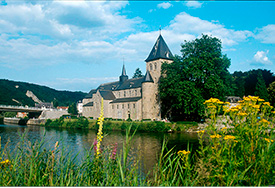
In the 11th century Irish monks settled on the banks of the Meuse and founded a Benedictine monastery there. This expanded over the centuries, encountering success and rivalries.
Built in 1033-1035 in the Mosan Romanesque architectural style, the abbey church was part of this abbey, established at its side until the 18th century. The Romanesque apse was demolished between 1260 and 1264 and a Gothic chancel with a remarkable ribbed vault was added to the abbey church.
Part of the monastery was burnt down by the Huguenots in 1568 and it was totally destroyed by the Revolutionaries in 1793. Restored in the 19th century, the abbey church is now one of the finest monuments of Romanesque art in Belgium. It symbolises faith, history and the vicissitudes of men.
Visitors will discover prestigious testimonies of history, including examples of Romanesque and Gothic art, stalls with misericords dating from 1443, wall paintings, tombstones, an outstanding statuary (Romanesque Virgin, sculptures by Lambert Lombart, 16th-century Calvary, triptych by Auguste Donnay) and even contemporary works of art, such as a Vietnamese Stations of the Cross.
But what really makes an impression is the richness of the crypt beneath the altar: Merovingian sarcophaguses, 12th-century graffiti, ancient reliquaries and many other remnants of the old abbey make visitors aware of its past and its roots.
Today every stone, every architectural element, every sculptured object evokes a particular view of the world and of mankind.
Route de Blaimont (face au n° 1) - Rue Moussia (face au n° 150)
5541 Hastière
Tel : 0032(0) 82 64 46 22
Web : http://www.patrimoinehastiere.be
À Hastière
D - The Hastière House of Heritage Voir sur la carte
A visit to this “workshop of the local memory” reveals around thirty professions represented by a wide range of tools and objects, mainly from the 19th and 20th centuries.
All these old items bear witness to a past that was ingenious but also laborious. They were created by men and women with their hands, their intelligence and their know-how.
In Hastière Museum, the working techniques and tools of times gone by are exhibited in various categories of themed collections: rural life, life on the river and industrial life.
Rue Marcel Lespagne,70
5540 Hastière
Tel : 0032(0) 82 64 46 22
Web : http://www.patrimoinehastiere.be
À Hastière
E - Reception and tourist information site Voir sur la carte
Office de Tourisme d'Hastière– www.hastiere.be
À Waulsort
F - Walk Voir sur la carte
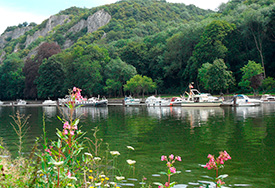
Le château Thierry
Creepers and ivy conceal a fortress forgotten by history. And yet in the Middle Ages, Château Thierry was one of the most powerful fortresses in the region! Perched on a rock spur, the castle overlooked the Meuse valley and its trade. The lords had no scruples about demanding ransoms from the traders and imposing passage duties on their boats. Château Thierry also provided protection for Waulsort Abbey, which stood at its feet: spiritual and lordly power provided mutual assistance.
Bon plan
De Waulsort, traversez la Meuse avec le bac et rejoignez cette belle balade assez physique. De beaux points de vue mènent aux ruines de château Thierry imbriquées dans la végétation. La fin de la promenade est superbe, en longeant la plaine alluviale de la Meuse.
Carnet pratique
Kilomètres : 3 km
Balisage : losange jaune
Difficulté : moyen, chaussures de rando conseillées !
Durée : 2h
Départ : débarcadère du passeur d'eau (auberge et panneau des balades).
Pour aller plus loin
Carte de promenades d'Hastière-sur-Meuse
À Waulsort
G - Walk

The small waterfalls
The foothills of the Meuse are no more than gullies where streams and brooks flow. This high, athletic walk leads to some delightful pastoral spots.
Practical details
Distance: 5 km
Waymarking: green diamond
Difficulty: difficult, walking shoes advisable!
Duration: 3h
Start: From the ferry landing stage (inn and panel showing walks).
To go further afield
Hastière-sur-Meuse walker’s map
Did you know ?
The Waulsort ferry carries on the long tradition of these ferryboats that carried people across the river where there were no bridges. Inaugurated in 1871, it took the inhabitants of Furfooz across to the other side, to Waulsort, from where they could catch a train.
Open from 1 April to 30 September, from 1.00 am to 6.00 pm (7.30 pm at the weekend).
“Le passeur d'eau, les mains aux rames,?
A contre flot, depuis longtemps,?
Luttait, un roseau vert entre les dents...”
'The ferryman, hands on oars,
Against the flow, long struggled,
A green reed between his teeth'
Emile Verhaeren - Le passeur d'eau (The Ferryman - 1895)
5540 Hastière
À Freyr
H - Freyr : Castle and Gardens Voir sur la carte

French-style classicism
While the fortresses of the Meuse valley stand on rocky spurs, that of Freyr, on the banks of the Meuse, was built to protect the ford crossing that served as a border between the Prince-Bishopric of Liège and the earldom of Namur, two constantly feuding states. It was to prove easy prey for the French troops of the Duke of Nevers, who destroyed it.
In the 16th and 17th centuries, tired of these feudal wars, the lords of the manors aspired to realise the sweet dream of “living nobly”. The architecture of the fortresses changed. Windows were opened and pleasure gardens replaced high walls. Freyr was no exception to the rule: it was to be rebuilt as a residence in 1571. Its garden was an ode to French classicism. Its geometry broke with the rugged landscape of the surrounding area. On the banks of the Meuse, Freyr Castle and its Renaissance style have lit up the valley for over 400 years.
Freyr,12
5540 Hastière
Tel : 0032(0) 82 22 22 00
Web : http://www.freyr.be
Did you know?
In the summer months the orange trees, which are over 250 years old, come out of the orangery and line the avenues of the geometric garden. Visiting Freyr is a pleasure for the senses.



